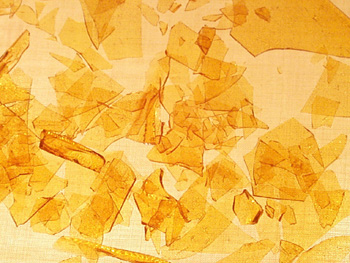In past decades the increasing popularity of classical guitars has prompted an unprecedented demand for this most beautiful instrument. Many small shops converted to mass production techniques to supply consumers with affordable instruments. Since the classical guitar's finish is one of the most time consuming steps in the construction of the guitar, age old finishing techniques were discarded in favor of finishes that were faster to apply. Economic considerations had to be taken into account in order to make new instruments as affordable as possible. Expensive labor was eliminated wherever necessary, even though there was an acoustic "price" to pay. As the popularity of classical guitars increased, it was soon discovered that guitarists were demanding better sounding, better quality guitars. Luthiers, who are always searching for the best sound in their hand-made instruments, soon discovered that there were many discerning musicians who were willing to pay the extra cost for French polished guitars.
 |
| Orville (left) and Bob Milburn |
French polishing is a method of applying shellac and has nothing to do with materials as the term may indicate. No "polish" is used in this method of finish. The term "French polishing" might have received its name from the extensive rubbing that is necessary to apply shellac smoothly and perfectly. It is agreed by most makers of handmade instruments, that the acoustic properties of French polish are far superior to that of any other finish. With a French-polished finish of shellac, the finish is only a few thousandths of an inch thick. The dampening properties of this finish are less than tougher synthetic finishes. The only drawback to the French polished guitars is the delicate nature of the finish compared to the hard, synthetic finishes provided on the factory-made instruments. Extra care must be taken to protect the finish from damage due to perspiration, moisture, and of course general abuse from fingernail scratches. Even though factory finished instruments are more durable, it is very difficult for the repair person to match these materials and repair them. If a French polished finish is damaged, it is the most forgiving to repair and touch up. We will cover some repair techniques in this article. Years ago, when we decided to learn the "old -world" way of French polishing, we were discouraged to find very little information on the subject. Most of the articles that we were able to find contained little more than a definition with a list of materials needed and very little instructional content. Just as frustrating to us was the fact that we could not find instructions on how to solve routine problems as they arose during our attempts at French polishing. Many of the articles were written as if nothing would ever go wrong, therefore, no explanation would ever be needed. We suspect that a step-by-step description of the entire French polishing procedure would be too lengthy which is usually beyond the scope of most publications. Instrument makers are often much more fussy about finishes so an article on French-polishing furniture may not translate well to the luthier.
 |
| A close-up of blond shellac flakes. This brand is called 'luna'. |
Our determination to learn French polishing began with reading the few short articles that were available, many long phone calls to experienced luthiers, and a huge phone bill. The most valuable information that we were able to obtain was from America's foremost French polishing experts, Eugene Clark and luthiers Cyndy Burton and Jeffery Elliott. Much of the information contained in this article comes directly from Mr. Clark's and Ms. Burton's methods and techniques as we learned and practiced them over the years. We will also try to detail possible problems and their solutions we have encountered. The reader should understand, however, that there are many very successful French polishers that do not necessarily use the same techniques as we do. This article is meant to get the beginner started with as much practical and useful information as possible. No doubt, as you gain experience, you will make discoveries and incorporate those ideas into your own methods. Remember, many skills and disciplines are accomplished in many different ways. This overview is divided into a number of lessons from which the beginner or the already experienced finisher may find useful information. By segmenting this article into lessons, future reference will also be easier. We will get started by explaining the nature of the materials that we will be using and then relate our step-by-step procedures to the French polishing of a guitar from start to completion. We will try to avoid complex terms and long technical explanations in this article since that is not our goal nor would it serve any beneficial purpose for the student.